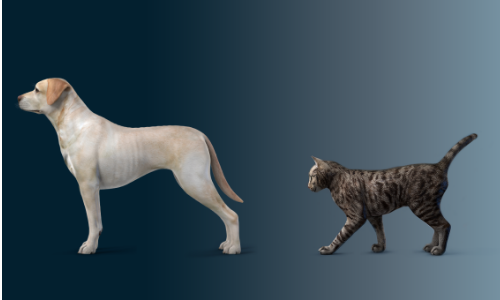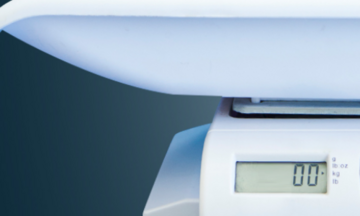定义健康身体状况

健康身体状况
对比单独评估体重,综合评估体重、身体状况评分和去脂体重更能反映猫、犬的整体健康状况。1
虽然定期监测体重是一种好习惯,但体重只是健康身体状况的评估要素之一。犬的品种存在众多差异,甚至还有混种犬,因此难以确定理想体重。此外,即使体重保持稳定,也会出现脂体重增加和去脂体重下降的情况。

这个链接指向一个英文视频,没有[中文]翻译
Purina 的科学家开发并验证了适用于猫、犬的 9 分制身体状况评分系统 (BCS)。2,3 BCS 系统可评估体外脂肪,并有助于估算宠物的最佳体重,无需考虑宠物的品种或体型。
该实用工具在已发表的同行评审研究中得到独立验证,目前获得世界小动物兽医协会 (WSAVA) 推荐,可为猫、犬体重管理提供支持,现已被全球兽医广泛采用。4-7
使用 9 分制 Purina BCS 系统时,理想的身体状况被定义为腰部明显(从上方观察)、腹部有赘肉(侧面轮廓),并且可以轻松触及肋骨。
犬的理想 BCS 定义为 4-5 分,猫则为 5 分。
BCS 为 8 分或 9 分的宠物被视为肥胖。

去脂体重
除了评估身体状况评分外,评估肌肉质量也很重要,有助于说明即使在超重宠物中也可能发生的去脂体重损失。8
去脂体重包括骨骼肌、器官和皮肤,基本上都是除脂肪以外的软组织。保持去脂体重对整体健康很重要。9-11 去脂体重是一个氨基酸库,猫、犬可以通过它组成蛋白质,这些蛋白质是每个细胞的基本组成部分,包括免疫细胞、红细胞和激素。
此外,去脂体重提供动物代谢率(燃烧卡路里的速度)消耗的 95%,与脂肪相比,去脂体重的百分比更高,通常会增加基础能量代谢。12
世界小动物兽医协会肌肉状况评分系统已在已发表的同行评审研究中得到验证,该系统提供了评估犬和猫肌肉质量损失的工具。8,13 基于视觉评估和触诊,肌肉质量被评为正常,或轻度、中度或重度肌肉损失。

需记住的要点
- 应定期监测宠物的身体状况评分、肌肉状况评分和体重。
- 使用 9 分制 Purina BCS 系统时,理想的身体状况被定义为腰部明显(从上方观察)、腹部有赘肉(侧面轮廓),并且可以轻松触及肋骨。
- 犬的理想 BCS 定义为 4-5 分,猫则为 5 分。
- 维持去脂体重对于总体健康也很重要,可以使用 WSAVA 猫、犬肌肉状况评分系统进行评估。
探索健康体重管理领域
了解更多信息
- Cline, M. G., Burns, K. M., Coe, J. B., Downing, R., Durzi, T., Murphy, M., & Parker, V. (2021). 2021 AAHA nutrition and weight management guidelines for dogs and cats. Journal of the American Animal Hospital Association, 57, 153–178.
- Laflamme, D. P. (1997). Development and validation of a body condition score system for dogs. Canine Practice, 22(4), 10–15.
- Laflamme, D. P. (1997). Development and validation of a body condition score system for cats: A clinical tool. Feline Practice, 25(5–6), 13–18.
- Bjørnvad, C. R., Nielsen, D. H., Armstrong, P. J., McEvoy, F., Hoelmkjaer, K. M., Jensen, K. S., Pedersen, G. F., & Kristensen, A. T. (2011). Evaluation of a nine-point body condition scoring system in physically inactive pet cats. American Journal of Veterinary Research, 72(4), 433–437.
- Bjørnvad, C. R., Nielsen, M. E., Hansen, S., & Nielsen, D. H. (2017). The effect of position on the precision of dual-energy X-ray absorptiometry and correlation with body condition score in dogs and cats. Journal of Nutritional Science, 6, e20.
- Mawby, D. I., Bartges, J. W., d’Avignon, A., Laflamme, D. P., Moyers, T. D., & Cottrell, T. (2004). Comparison of various methods for estimating body fat in dogs. Journal of the American Animal Hospital Association, 40(2), 109–114.
- German, A. J. (2006). The growing problem of obesity in dogs and cats. Journal of Nutrition, 136, 1940S–1946S.
- Freeman, L. M., Michel, K. E., Zanghi, B. M., Vester Boler, B. M., & Fages, J. (2019). Evaluation of the use of muscle condition score and ultrasonographic measurements for assessment of muscle mass in dogs. American Journal of Veterinary Research, 80(6), 595–600.
- Kealy, R. D., Lawler, D. F., Ballam, J. M., Mantz, S. L., Biery, D. N., Greeley, E. H., Lust, G., Segre, M., Smith G. K., & Stowe, H. D. (2002). Effects of diet restriction on life span and age-related changes in dogs. Journal of the American Veterinary Medical Association, 220(9), 1315–1320.
- Cupp, C. J., Kerr, W. W., Jean-Philippe, C., Patil, A. R., & Perez-Camargo, G. (2008). The role of nutritional interventions in the longevity and maintenance of long-term health in aging cats. International Journal of Applied Research in Veterinary Medicine, 6(2), 69–81.
- Penell, J. C., Morgan, D. M., Watson, P., Carmichael, S., & Adams, V. J. (2019). Body weight at 10 years of age and change in body composition between 8 and 10 years of age were related to survival in a longitudinal study of 39 Labrador retriever dogs. Acta Veterinaria Scandinavica, 61(1), 42.
- Harper, E. J. (1998). Changing perspectives on aging and energy requirement: Aging, body weight and body composition in humans, dogs and cats. Journal of Nutrition, 128, 2627S–2631S.
- Michel, K. E., Anderson, W., Cupp, C., & Laflamme, D. P. (2011). Correlation of a feline muscle mass score with body composition determined by dual-energy X-ray absorptiometry. British Journal of Nutrition, 106, S57–S59.



